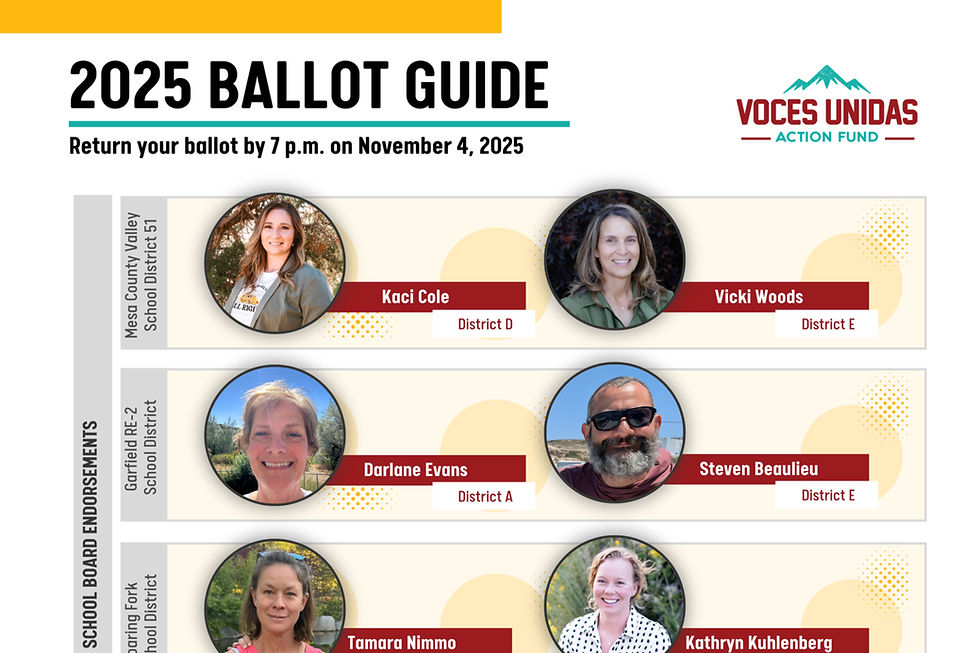Roaring Fork RE-1 continues one of Colorado’s largest Latino–White student achievement gaps across all subjects
- Voces Unidas de las Montañas

- Sep 10
- 3 min read
The recently released 2025 Colorado Measures of Academic Success (CMAS) results show the Roaring Fork School District (RE-1) again posting very low Latino proficiency across English Language Arts (reading and writing), Math, and Science — with Latino student achievement stuck in the teens for the third straight year. The Latino–White gap in CMAS results remains among the largest in Colorado and shows no signs of closing.
For the 2024–2025 school year, only 18.5% of Latino students in grades 3–8 met or exceeded expectations in reading and writing, compared with 60.3% of White students — a 41.8-point gap. In Math, Latino proficiency is just 11.7%, versus 49.1% for White students — a 37.4-point gap. In Science (grades 5 and 8), Latino proficiency is 11.8% versus 53.0% for White students — a 41.2-point gap. High participation rates across groups confirm these results reflect instructional outcomes, not test participation.
“The data suggests that Latino students are still not getting consistent grade-level instruction, much less catching up the two or three grades they are currently behind before getting to high school,” said Alex Sánchez, president and CEO of Voces Unidas, a Glenwood Springs-based Latino advocacy group. “We need results, not excuses, because the status quo — and this pace — are unacceptable.”
These results come after more than a decade of strategic plans and reform initiatives in the Roaring Fork School District that have failed to deliver measurable improvement. Latino proficiency has remained below 20% across all subjects, while achievement gaps have held between 37 and 41 percentage points for three consecutive years. Rather than shrinking, the gaps have persisted or widened, offering no evidence that students are making up lost ground.
In a Nov. 30, 2008 Aspen Times story, the Roaring Fork RE-1’s Latino–White achievement gap was reported to be about 40 percentage points in key subjects. Judy Haptonstall, the superintendent at the time, said the goal then was to close the gap by 3 percentage points each year.
Sixteen years later, the district’s gaps remain virtually the same.
“For decades, district leaders have promised to shrink a 40-point gap with their brand new strategic plans or reforms,” said Sánchez. “Today, the gap is still at 40 points. That is not progress — that is failing to solve the problem.”
The same disparities extend into high school. Unlike CMAS, which measures grade-level proficiency in state standards, the PSAT (Preliminary SAT, taken in grades 9–11) and the SAT (college entrance exam taken in grade 11) measure college readiness and are used nationally. In 2025, Latino students’ combined SAT/PSAT scores (ELA and Math) were 179–234 points lower than White students, depending on grade. On the 2025 SAT, about 1 in 7 Latino students met the Math benchmark and about 1 in 3 met the Reading and Writing benchmark.
“These outcomes show that the system is failing students at every step — from third grade CMAS through high school SATs,” said Sánchez. “The gaps are not closing, they are compounding. By the time Latino students are taking college entrance exams, they are already years behind their White peers.”
The 2025 CMAS and SAT results are not bad news for all families in the Roaring Fork School District. Historically, White students in Roaring Fork RE-1 have achieved at higher rates, making the district a strong academic option for those families. In 2025, White students are effectively receiving a 40% better quality education compared to their Latino peers, who make up 57% of the district population.
“We call ourselves a progressive community, yet we normalize failing more than half of our students year after year,” said Sánchez. “This is about fairness. If the same outcomes applied to White students, parents in this valley would have already demanded and made drastic changes to protect their children’s future. Latino students deserve nothing less.”
Latino parents are also losing trust. A recent poll led by Voces Unidas found that three-in-ten Latino parents lack confidence that their schools will close achievement gaps, while more than a quarter doubt that their districts are willing to involve Latino families in decision-making. Strong majorities of Latino parents now support greater state enforcement powers to hold school districts accountable, and many are prepared to push for leadership changes if local officials remain unresponsive.
The district must now confront a simple reality: a decade of plans have not produced the intended results. Unless district leaders are willing to double-down on accelerating learning by multiple grade levels — not just incremental change — another generation of Latino students will leave Roaring Fork schools years behind their peers.






